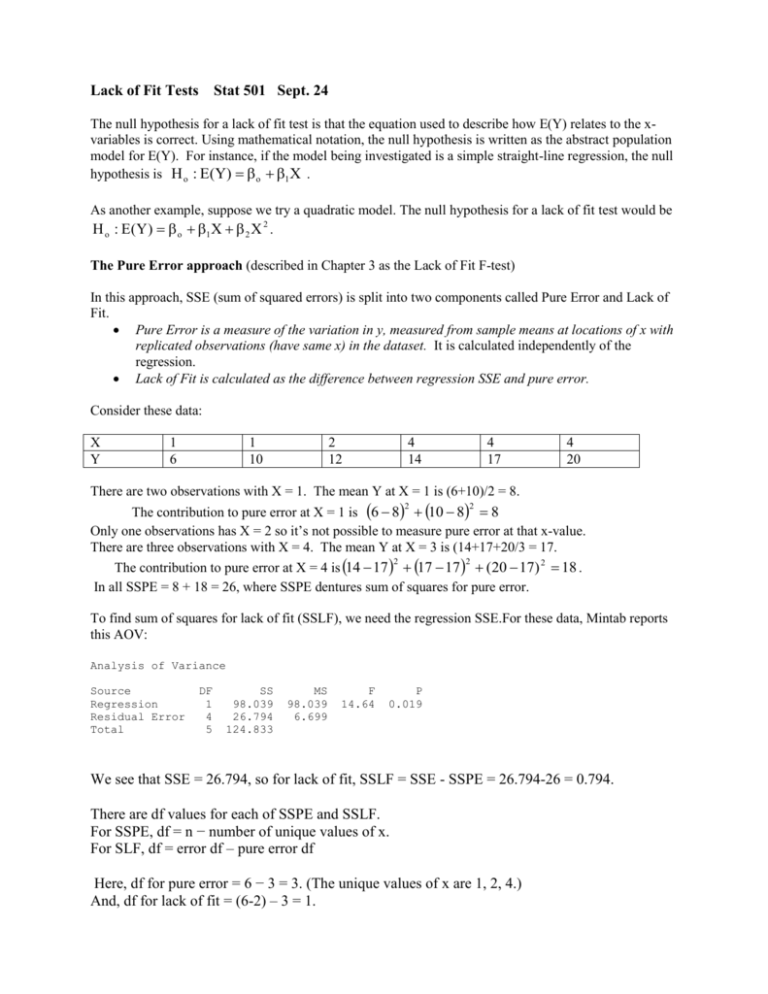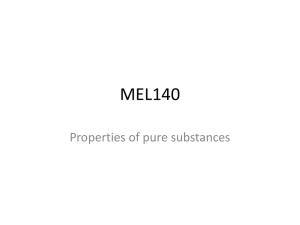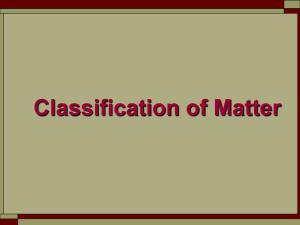Lack of Fit Tests Stat 501 Sept
advertisement

Lack of Fit Tests Stat 501 Sept. 24 The null hypothesis for a lack of fit test is that the equation used to describe how E(Y) relates to the xvariables is correct. Using mathematical notation, the null hypothesis is written as the abstract population model for E(Y). For instance, if the model being investigated is a simple straight-line regression, the null hypothesis is H o : E(Y) o 1 X . As another example, suppose we try a quadratic model. The null hypothesis for a lack of fit test would be H o : E ( Y ) o 1 X 2 X 2 . The Pure Error approach (described in Chapter 3 as the Lack of Fit F-test) In this approach, SSE (sum of squared errors) is split into two components called Pure Error and Lack of Fit. Pure Error is a measure of the variation in y, measured from sample means at locations of x with replicated observations (have same x) in the dataset. It is calculated independently of the regression. Lack of Fit is calculated as the difference between regression SSE and pure error. Consider these data: X Y 1 6 1 10 2 12 4 14 4 17 4 20 There are two observations with X = 1. The mean Y at X = 1 is (6+10)/2 = 8. The contribution to pure error at X = 1 is 6 8 10 8 8 Only one observations has X = 2 so it’s not possible to measure pure error at that x-value. There are three observations with X = 4. The mean Y at X = 3 is (14+17+20/3 = 17. 2 2 The contribution to pure error at X = 4 is 14 17 17 17 (20 17) 2 18 . In all SSPE = 8 + 18 = 26, where SSPE dentures sum of squares for pure error. 2 2 To find sum of squares for lack of fit (SSLF), we need the regression SSE.For these data, Mintab reports this AOV: Analysis of Variance Source Regression Residual Error Total DF 1 4 5 SS 98.039 26.794 124.833 MS 98.039 6.699 F 14.64 P 0.019 We see that SSE = 26.794, so for lack of fit, SSLF = SSE - SSPE = 26.794-26 = 0.794. There are df values for each of SSPE and SSLF. For SSPE, df = n − number of unique values of x. For SLF, df = error df – pure error df Here, df for pure error = 6 − 3 = 3. (The unique values of x are 1, 2, 4.) And, df for lack of fit = (6-2) – 3 = 1. Defining an MS value as SS/df gives MSPE and MSLF values. The statistic F = MSLF/MSPE is an F-statistic used to test the null hypothesis. Degrees of freedom, numerator and denominator, are given by the pure error and lack of fit df’s respectively. Here’s the Minitab result for our example. Source Regression Residual Error Lack of Fit Pure Error Total DF 1 4 1 3 5 SS 98.039 26.794 0.794 26.000 124.833 MS 98.039 6.699 0.794 8.667 F 14.64 P 0.019 0.09 0.782 The SS values for lack of fit and pure error are the values we calculated above. The p-value is p= 0.782 for the F-test of lack of fit. Hence, we do not reject the null hypothesis that the straightline model is correct. Following is the result we saw in the lab Wednesday for Y = chemical concentration versus X = time since solution was made. In this case, we reject the straight-line model. Source Regression Residual Error Lack of Fit Pure Error Total DF 1 13 3 10 14 SS 12.597 2.925 2.767 0.157 15.522 MS 12.597 0.225 0.922 0.016 F 55.99 P 0.000 58.60 0.000 Data Subsetting Approach of Minitab If n=1 at each unique value of x, pure error cannot be calculated. Minitab offers an alternative test. It’s hard to find a description of precisely what Minitab does for it’s data subsetting. Here, though, are the basic ideas. The null hypothesis is still that the model for E(Y) is correct. The range of x-values is divided into sub-regions (three I think). A model is fit in which the slope is allowed to be different in each region. This approximates a curved model. The sum of squared errors from this model is used as pure error sum of squares. The lack of fit SS is, as before, the difference between SSE from the regression model and the approximate SS for pure error. An approximate F test comparing lack of fit to pure error is done. Also, Minitab only looks at what’s happening in the outer two regions of x. The thinking is that consequences of using a wrong model are exaggerated in these outer regions. Following is the result for the tumor size problem done in Wednesday’s lab. The small p-values indicate we should reject the straight-line model. Lack of fit test Possible curvature in variable Time (P-Value = 0.002 ) Possible lack of fit at outer X-values (P-Value = 0.000) Overall lack of fit test is significant at P = 0.000









